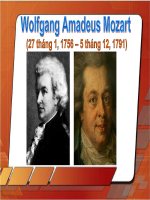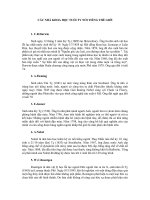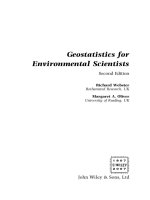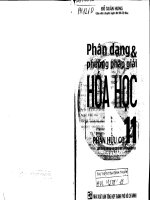Jie jack li name reactions a collection of deta
Bạn đang xem bản rút gọn của tài liệu. Xem và tải ngay bản đầy đủ của tài liệu tại đây (4.34 MB, 644 trang )
Name Reactions
Fourth Expanded Edition
Jie Jack Li
Name Reactions
A Collection of Detailed Mechanisms
and Synthetic Applications
Fourth Expanded Edition
123
Jie Jack Li, Ph.D.
Discovery Chemistry
Bristol-Myers Squibb Company
5 Research Parkway
Wallingford, CT 06492
USA
ISBN 978-3-642-01052-1
e-ISBN 978-3-642-01053-8
DOI 10.1007/978-3-642-01053-8
Springer Dordrecht Heidelberg London New York
Library of Congress Control Number: 2009931220
c Springer-Verlag Berlin Heidelberg 2009
This work is subject to copyright. All rights are reserved, whether the whole or part of the material is
concerned, specifically the rights of translation, reprinting, reuse of illustrations, recitation, broadcasting,
reproduction on microfilm or in any other way, and storage in data banks. Duplication of this publication
or parts thereof is permitted only under the provisions of the German Copyright Law of September 9,
1965, in its current version, and permission for use must always be obtained from Springer. Violations
are liable to prosecution under the German Copyright Law.
The use of general descriptive names, registered names, trademarks, etc. in this publication does not
imply, even in the absence of a specific statement, that such names are exempt from the relevant protective
laws and regulations and therefore free for general use.
Cover design: K¨unkelLopka GmbH
Printed on acid-free paper
Springer is part of Springer Science+Business Media (www.springer.com)
To Vivien
Foreword
I don't have my name on anything that I don't really do.
–Heidi Klum
Can the organic chemists associated with so-called “Named Reactions” make the
same claim as supermodel Heidi Klum? Many scholars of chemistry do not
hesitate to point out that the names associated with “name reactions” are often not
the actual inventors. For instance, the Arndt–Eistert reaction has nothing to do
with either Arndt or Eistert, Pummerer did not discover the “Pummerer”
rearrangement, and even the famous Birch reduction owes its initial discovery to
someone named Charles Wooster (first reported in a DuPont patent). The list goes
on and on…
But does that mean we should ignore, boycott, or outlaw “named
reactions”? Absolutely not. The above examples are merely exceptions to the rule.
In fact, the chemists associated with name reactions are typically the original
discoverers, contribute greatly to its general use, and/or are the first to popularize
the transformation. Regardless of the controversial history underlying certain
named reactions, it is the students of organic chemistry who benefit the most from
the cataloging of reactions by name. Indeed, it is with education in mind that Dr.
Jack Li has masterfully brought the chemical community the latest edition of
Name Reactions.
It is clear why this beautiful treatise has rapidly become a bestseller
within the chemical community. The quintessence of hundreds of named
reactions is encapsulated in a concise format that is ideal for students and
seasoned chemists alike. Detailed mechanistic and occasionally even historical
details are given for hundreds of reactions along with key references. This “musthave” book will undoubtedly find a place on the bookshelves of all serious
practitioners and students of the art and science of synthesis.
Phil S. Baran
May 2009
La Jolla, California
Preface
The first three editions of this book have been warmly embraced by the organic
chemistry community. Many readers have indicated that while they like the
detailed mechanisms, they prefer to have more real case applications in synthesis.
For this edition, we have revolutionized the format, which finally liberated more
space to accomodate many more synthetic examples. As a consequence, the
subtitle of the book has been changed to A Collection of Detailed Mechanisms and
Synthetic Applications. When putting together the 4th edition, I also strived to capture the latest references, up to 2009 whenever possible. Coincidentally, my
daughter Vivien, a sophomore at the University of Michigan, will take soon Organic Chemistry. I hope she finds this book useful in preparing for her exams.
I am very much indebted to the readers who have kindly written to me with
suggestions, which helped transform this book into a useful reference book for
senior undergrate and graduate students around the world—the second edition was
translated to both Chinese and Russian. I am grateful to my good friend Derek A.
Pflum at Ash Stevens Inc. who kindly proofead the entire manuscript and
provided many invaluable suggestions. Prof. Derrick L. J. Clive at University of
Alberta also proofread the first half of the manuscript and offered helpful
comments. I also wish to thank Prof. Phil S. Baran at Scripps Research Institute
and his students, Tanja Gulder, Yoshi Ishihara, Chad A. Lewis, Jonathan Lockner,
Jun Cindy Shi, and Ian B. Seiple for proofreading the final draft of the manuscript.
Their knowledge and time have tremendously enhanced the quality of this book.
Any remaining errors are, of course, solely my own responsibility.
As always, I welcome your critique!
Jie Jack Li
May 2009
Killingworth, Connecticut
Table of Contents
Foreword............................................................................................................... VII
Preface .................................................................................................................. IX
Abbreviations ....................................................................................................... XIX
Alder ene reaction ..................................................................................................... 1
Aldol condensation.................................................................................................... 3
Algar–Flynn–Oyamada reaction ............................................................................... 6
Allan–Robinson reaction........................................................................................... 8
Arndt–Eistert homologation.................................................................................... 10
Baeyer–Villiger oxidation ....................................................................................... 12
Baker–Venkataraman rearrangement...................................................................... 14
Bamford–Stevens reaction ...................................................................................... 16
Barbier coupling reaction ........................................................................................ 18
Bartoli indole synthesis ........................................................................................... 20
Barton radical decarboxylation ............................................................................... 22
Barton–McCombie deoxygenation ......................................................................... 24
Barton nitrite photolysis .......................................................................................... 26
Batcho–Leimgruber indole synthesis...................................................................... 28
Baylis–Hillman reaction.......................................................................................... 30
Beckmann rearrangement........................................................................................ 33
Abnormal Beckmann rearrangement ............................................................ 34
Benzilic acid rearrangement.................................................................................... 36
Benzoin condensation.............................................................................................. 38
Bergman cyclization................................................................................................ 40
Biginelli pyrimidone synthesis................................................................................ 42
Birch reduction ........................................................................................................ 44
Bischler–Möhlau indole synthesis .......................................................................... 46
Bischler–Napieralski reaction ................................................................................. 48
Blaise reaction ........................................................................................................ 50
Blum–Ittah aziridine synthesis ............................................................................... 52
Boekelheide reaction ............................................................................................... 54
Boger pyridine synthesis ......................................................................................... 56
Borch reductive amination ...................................................................................... 58
Borsche–Drechsel cyclization................................................................................. 60
Boulton–Katritzky rearrangement........................................................................... 62
Bouveault aldehyde synthesis ................................................................................. 64
Bouveault–Blanc reduction..................................................................................... 65
Bradsher reaction..................................................................................................... 66
Brook rearrangement............................................................................................... 68
Brown hydroboration .............................................................................................. 70
Bucherer carbazole synthesis .................................................................................. 72
XII
Bucherer reaction..................................................................................................... 74
Bucherer–Bergs reaction ......................................................................................... 76
Büchner ring expansion........................................................................................... 78
Buchwald–Hartwig amination ................................................................................ 80
Burgess dehydrating reagent................................................................................... 84
Burke boronates....................................................................................................... 87
Cadiot–Chodkiewicz coupling................................................................................ 90
Camps quinoline synthesis...................................................................................... 92
Cannizzaro reaction................................................................................................. 94
Carroll rearrangement ............................................................................................. 96
Castro–Stephens coupling....................................................................................... 98
Chan alkyne reduction........................................................................................... 100
Chan–Lam C–X coupling reaction ....................................................................... 102
Chapman rearrangement ....................................................................................... 105
Chichibabin pyridine synthesis ............................................................................. 107
Chugaev reaction................................................................................................... 110
Ciamician–Dennsted rearrangement..................................................................... 112
Claisen condensation............................................................................................. 113
Claisen isoxazole synthesis................................................................................... 115
Claisen rearrangement........................................................................................... 117
para-Claisen rearrangement ....................................................................... 119
Abnormal Claisen rearrangement ................................................................ 121
Eschenmoser–Claisen amide acetal rearrangement .................................... 123
Ireland–Claisen (silyl ketene acetal) rearrangement ................................... 125
Johnson–Claisen (orthoester) rearrangement .............................................. 127
Clemmensen reduction.......................................................................................... 129
Combes quinoline synthesis.................................................................................. 131
Conrad–Limpach reaction..................................................................................... 133
Cope elimination reaction ..................................................................................... 135
Cope rearrangement .............................................................................................. 137
Anionic oxy-Cope rearrangement................................................................. 138
Oxy-Cope rearrangement.............................................................................. 140
Siloxy-Cope rearrangement .......................................................................... 141
Corey–Bakshi–Shibata (CBS) reagent ................................................................. 143
Corey−Chaykovsky reaction................................................................................. 146
Corey–Fuchs reaction............................................................................................ 148
Corey–Kim oxidation............................................................................................ 150
Corey–Nicolaou macrolactonization .................................................................... 152
Corey–Seebach reaction........................................................................................ 154
Corey–Winter olefin synthesis.............................................................................. 156
Criegee glycol cleavage ........................................................................................ 159
Criegee mechanism of ozonolysis ........................................................................ 161
Curtius rearrangement........................................................................................... 162
Dakin oxidation ..................................................................................................... 165
Dakin–West reaction............................................................................................. 167
Darzens condensation............................................................................................ 169
XIII
Delépine amine synthesis...................................................................................... 171
de Mayo reaction................................................................................................... 173
Demjanov rearrangement...................................................................................... 175
Tiffeneau–Demjanov rearrangement ............................................................ 177
Dess–Martin periodinane oxidation ...................................................................... 179
Dieckmann condensation ...................................................................................... 182
Diels–Alder reaction.............................................................................................. 184
Inverse electronic demand Diels–Alder reaction ......................................... 186
Hetero-Diels–Alder reaction ........................................................................ 187
Dienone–phenol rearrangement ............................................................................ 190
Di-π-methane rearrangement ................................................................................ 192
Doebner quinoline synthesis ................................................................................. 194
Doebner–von Miller reaction ................................................................................ 196
Dötz reaction.......................................................................................................... 198
Dowd–Beckwith ring expansion........................................................................... 200
Dudley reagent....................................................................................................... 202
Erlenmeyer−Plöchl azlactone synthesis................................................................ 204
Eschenmoser’s salt ................................................................................................ 206
Eschenmoser–Tanabe fragmentation .................................................................... 208
Eschweiler–Clarke reductive alkylation of amines .............................................. 210
Evans aldol reaction .............................................................................................. 212
Favorskii rearrangement........................................................................................ 214
Quasi-Favorskii rearrangement..................................................................... 217
Feist–Bénary furan synthesis ................................................................................ 218
Ferrier carbocyclization......................................................................................... 220
Ferrier glycal allylic rearrangement...................................................................... 222
Fiesselmann thiophene synthesis .......................................................................... 225
Fischer indole synthesis ........................................................................................ 227
Fischer oxazole synthesis ...................................................................................... 229
Fleming–Kumada oxidation ................................................................................. 231
Tamao−Kumada oxidation............................................................................ 233
Friedel–Crafts reaction.......................................................................................... 234
Friedel–Crafts acylation reaction.................................................................. 234
Friedel–Crafts alkylation reaction................................................................. 236
Friedländer quinoline synthesis ............................................................................ 238
Fries rearrangement............................................................................................... 240
Fukuyama amine synthesis ................................................................................... 243
Fukuyama reduction .............................................................................................. 245
Gabriel synthesis ................................................................................................... 246
Ing–Manske procedure.................................................................................. 249
Gabriel–Colman rearrangement............................................................................ 250
Gassman indole synthesis...................................................................................... 251
Gattermann–Koch reaction ................................................................................... 253
Gewald aminothiophene synthesis........................................................................ 254
Glaser coupling...................................................................................................... 257
Eglinton coupling .......................................................................................... 259
XIV
Gomberg–Bachmann reaction............................................................................... 262
Gould–Jacobs reaction .......................................................................................... 263
Grignard reaction................................................................................................... 266
Grob fragmentation ............................................................................................... 268
Guareschi–Thorpe condensation........................................................................... 270
Hajos–Wiechert reaction....................................................................................... 271
Haller–Bauer reaction ........................................................................................... 273
Hantzsch dihydropyridine synthesis ..................................................................... 274
Hantzsch pyrrole synthesis.................................................................................... 276
Heck reaction......................................................................................................... 277
Heteroaryl Heck reaction .............................................................................. 280
Hegedus indole synthesis ...................................................................................... 281
Hell–Volhard–Zelinsky reaction........................................................................... 282
Henry nitroaldol reaction ...................................................................................... 284
Hinsberg synthesis of thiophene derivatives ........................................................ 286
Hiyama cross-coupling reaction ........................................................................... 288
Hofmann rearrangement ....................................................................................... 290
Hofmann–Löffler–Freytag reaction...................................................................... 292
Horner–Wadsworth–Emmons reaction ................................................................ 294
Houben–Hoesch synthesis .................................................................................... 296
Hunsdiecker–Borodin reaction ............................................................................. 298
Jacobsen–Katsuki epoxidation.............................................................................. 300
Japp–Klingemann hydrazone synthesis................................................................ 302
Jones oxidation ...................................................................................................... 304
Collins–Sarett oxidation................................................................................ 305
PCC oxidation ............................................................................................... 306
PDC oxidation ............................................................................................... 307
Julia–Kocienski olefination................................................................................... 309
Julia–Lythgoe olefination ..................................................................................... 311
Kahne glycosidation.............................................................................................. 313
Knoevenagel condensation ................................................................................... 315
Knorr pyrazole synthesis....................................................................................... 317
Koch–Haaf carbonylation ..................................................................................... 319
Koenig–Knorr glycosidation................................................................................. 320
Kostanecki reaction ............................................................................................... 322
Kröhnke pyridine synthesis................................................................................... 323
Kumada cross-coupling reaction........................................................................... 325
Lawesson’s reagent ............................................................................................... 328
Leuckart–Wallach reaction ................................................................................... 330
Lossen rearrangement ........................................................................................... 332
McFadyen–Stevens reduction............................................................................... 334
McMurry coupling ................................................................................................ 335
Mannich reaction................................................................................................... 337
Martin’s sulfurane dehydrating reagent................................................................ 339
Masamune–Roush conditions ............................................................................... 341
Meerwein’s salt ..................................................................................................... 343
XV
Meerwein–Ponndorf–Verley reduction ................................................................ 345
Meisenheimer complex ......................................................................................... 347
[1,2]-Meisenheimer rearrangement ...................................................................... 349
[2,3]-Meisenheimer rearrangement....................................................................... 350
Meyers oxazoline method ..................................................................................... 351
Meyer–Schuster rearrangement ............................................................................ 353
Michael addition.................................................................................................... 355
Michaelis–Arbuzov phosphonate synthesis.......................................................... 357
Midland reduction ................................................................................................. 359
Minisci reaction ..................................................................................................... 361
Mislow–Evans rearrangement............................................................................... 363
Mitsunobu reaction................................................................................................ 365
Miyaura borylation ................................................................................................ 368
Moffatt oxidation................................................................................................... 370
Morgan–Walls reaction ........................................................................................ 371
Mori–Ban indole synthesis.................................................................................... 373
Mukaiyama aldol reaction..................................................................................... 375
Mukaiyama Michael addition ............................................................................... 377
Mukaiyama reagent ............................................................................................... 379
Myers−Saito cyclization........................................................................................ 382
Nazarov cyclization............................................................................................... 383
Neber rearrangement ............................................................................................. 385
Nef reaction ........................................................................................................... 387
Negishi cross-coupling reaction............................................................................ 389
Nenitzescu indole synthesis .................................................................................. 391
Newman−Kwart reaction ...................................................................................... 393
Nicholas reaction ................................................................................................... 395
Nicolaou dehydrogenation .................................................................................... 397
Noyori asymmetric hydrogenation........................................................................ 399
Nozaki–Hiyama–Kishi reaction ............................................................................ 401
Nysted reagent ....................................................................................................... 403
Oppenauer oxidation ............................................................................................. 404
Overman rearrangement........................................................................................ 406
Paal thiophene synthesis........................................................................................ 408
Paal–Knorr furan synthesis ................................................................................... 409
Paal–Knorr pyrrole synthesis ................................................................................ 411
Parham cyclization ................................................................................................ 413
Passerini reaction................................................................................................... 415
Paternò–Büchi reaction ......................................................................................... 417
Pauson–Khand reaction......................................................................................... 419
Payne rearrangement ............................................................................................. 421
Pechmann coumarin synthesis .............................................................................. 423
Perkin reaction....................................................................................................... 424
Petasis reaction ...................................................................................................... 426
Petasis reagent ....................................................................................................... 428
Peterson olefination............................................................................................... 430
XVI
Pictet–Gams isoquinoline synthesis...................................................................... 432
Pictet–Spengler tetrahydroisoquinoline synthesis ................................................ 434
Pinacol rearrangement........................................................................................... 436
Pinner reaction....................................................................................................... 438
Polonovski reaction ............................................................................................... 440
Polonovski–Potier rearrangement......................................................................... 442
Pomeranz–Fritsch reaction.................................................................................... 444
Schlittler–Müller modification ..................................................................... 446
Prévost trans-dihydroxylation .............................................................................. 447
Prins reaction......................................................................................................... 448
Pschorr cyclization ................................................................................................ 450
Pummerer rearrangement...................................................................................... 452
Ramberg–Bäcklund reaction................................................................................. 454
Reformatsky reaction ............................................................................................ 456
Regitz diazo synthesis ........................................................................................... 458
Reimer–Tiemann reaction..................................................................................... 460
Reissert reaction.................................................................................................... 461
Reissert indole synthesis ....................................................................................... 463
Ring-closing metathesis (RCM)........................................................................... 465
Ritter reaction ........................................................................................................ 468
Robinson annulation.............................................................................................. 470
Robinson–Gabriel synthesis.................................................................................. 472
Robinson–Schöpf reaction .................................................................................... 474
Rosenmund reduction............................................................................................ 476
Rubottom oxidation............................................................................................... 478
Rupe rearrangement .............................................................................................. 480
Saegusa oxidation.................................................................................................. 482
Sakurai allylation reaction .................................................................................... 484
Sandmeyer reaction ............................................................................................... 486
Schiemann reaction ............................................................................................... 488
Schmidt rearrangement ......................................................................................... 490
Schmidt’s trichloroacetimidate glycosidation reaction ........................................ 492
Shapiro reaction..................................................................................................... 494
Sharpless asymmetric amino hydroxylation......................................................... 496
Sharpless asymmetric dihydroxylation................................................................. 499
Sharpless asymmetric epoxidation ....................................................................... 502
Sharpless olefin synthesis ..................................................................................... 505
Simmons–Smith reaction ..................................................................................... 507
Skraup quinoline synthesis.................................................................................... 509
Smiles rearrangement............................................................................................ 511
Truce−Smile rearrangement ......................................................................... 513
Sommelet reaction................................................................................................. 515
Sommelet–Hauser rearrangement......................................................................... 517
Sonogashira reaction ............................................................................................. 519
Staudinger ketene cycloaddition ........................................................................... 521
Staudinger reduction ............................................................................................. 523
XVII
Stetter reaction....................................................................................................... 525
Still–Gennari phosphonate reaction...................................................................... 527
Stille coupling........................................................................................................ 529
Stille–Kelly reaction.............................................................................................. 531
Stobbe condensation.............................................................................................. 532
Strecker amino acid synthesis ............................................................................... 534
Suzuki–Miyaura coupling ..................................................................................... 536
Swern oxidation..................................................................................................... 538
Takai reaction ........................................................................................................ 540
Tebbe olefination................................................................................................... 542
TEMPO oxidation ................................................................................................. 544
Thorpe−Ziegler reaction........................................................................................ 546
Tsuji–Trost allylation ............................................................................................ 548
Ugi reaction ........................................................................................................... 551
Ullmann coupling .................................................................................................. 554
van Leusen oxazole synthesis ............................................................................... 556
Vilsmeier–Haack reaction ..................................................................................... 558
Vinylcyclopropane−cyclopentene rearrangement ................................................ 560
von Braun reaction ................................................................................................ 562
Wacker oxidation .................................................................................................. 564
Wagner–Meerwein rearrangement........................................................................ 566
Weiss–Cook reaction............................................................................................. 568
Wharton reaction ................................................................................................... 570
White reagent......................................................................................................... 572
Willgerodt–Kindler reaction ................................................................................. 576
Wittig reaction ....................................................................................................... 578
Schlosser modification of the Wittig reaction ............................................. 580
[1,2]-Wittig rearrangement ................................................................................... 582
[2,3]-Wittig rearrangement ................................................................................... 584
Wohl–Ziegler reaction........................................................................................... 586
Wolff rearrangement ............................................................................................. 588
Wolff–Kishner reduction....................................................................................... 590
Woodward cis-dihydroxylation............................................................................. 592
Yamaguchi esterification....................................................................................... 594
Zincke reaction ...................................................................................................... 596
Subject Index ......................................................................................................... 599
Abbreviations and Acronyms
3CC
4CC
9-BBN
A
Ac
ADDP
AIBN
Alpine-borane®
AOM
Ar
B:
[bimim]Cl•2AlCl3
BINAP
Bn
Boc
BT
Bz
Cbz
CuTC
DABCO
dba
DBU
DCC
DDQ
de
DEAD
(DHQ)2-PHAL
(DHQD)2-PHAL
DIAD
DIBAL
DIPEA
DMA
DMAP
DME
DMF
DMFDMA
DMS
DMSO
DMSY
DMT
DPPA
dppb
polymer support
three-component condensation
four-component condensation
9-borabicyclo[3.3.1]nonane
adenosine
acetyl
1,1'-(azodicarbonyl)dipiperidine
2,2ƍ-azobisisobutyronitrile
B-isopinocampheyl-9-borabicyclo[3.3.1]-nonane
p-Anisyloxymethyl = p-MeOC6H4OCH2aryl
generic base
1-butyl-3-methylimidazolium chloroaluminuminate
2,2ƍ-bis(diphenylphosphino)-1,1ƍ-binaphthyl
benzyl
tert-butyloxycarbonyl
benzothiazole
benzoyl
benzyloxycarbonyl
copper thiophene-2-carboxylate
1,4-diazabicyclo[2.2.2]octane
dibenzylideneacetone
1,8-diazabicyclo[5.4.0]undec-7-ene
1,3-dicyclohexylcarbodiimide
2,3-dichloro-5,6-dicyano-1,4-benzoquinone
diastereoselctive excess
diethyl azodicarboxylate
1,4-bis(9-O-dihydroquinine)-phthalazine
1,4-bis(9-O-dihydroquinidine)-phthalazine
diisopropyl azodidicarboxylate
diisobutylaluminum hydride
diisopropylethylamine
N,N-dimethylacetamide
4-N,N-dimethylaminopyridine
1,2-dimethoxyethane
N,N-dimethylformamide
N,N-dimethylformamide dimethyl acetal
dimethylsulfide
dimethylsulfoxide
dimethylsulfoxonium methylide
dimethoxytrityl
diphenylphosphoryl azide
1,4-bis(diphenylphosphino)butane
XX
dppe
dppf
dppp
dr
DTBAD
DTBMP
E1
E1cB
E2
EAN
EDDA
ee
Ei
Eq
Et
EtOAc
HMDS
HMPA
HMTTA
IBX
Imd
KHMDS
LAH
LDA
LHMDS
LTMP
M
m-CPBA
MCRs
Mes
MPS
Ms
MWI
MVK
NBS
NCS
NIS
NMP
Nos
N-PSP
N-PSS
Nu
PCC
PDC
Piv
1,2-bis(diphenylphosphino)ethane
1,1ƍ-bis(diphenylphosphino)ferrocene
1,3-bis(diphenylphosphino)propane
diastereoselctive ratio
di-tert-butylazodicarbonate
2,6-di-tert-butyl-4-methylpyridine
unimolecular elimination
2-step, base-induced β-elimination via carbanion
bimolecular elimination
ethylammonium nitrate
ethylenediamine diacetate
enantiomeric excess
two groups leave at about the same time and bond to
each other as they are doing so.
equivalent
ethyl
ethyl acetate
hexamethyldisilazane
hexamethylphosphoramide
1,1,4,7,10,10-hexamethyltriethylenetetramine
o-iodoxybenzoic acid
imidazole
potassium hexamethyldisilazide
lithium aluminum hydride
lithium diisopropylamide
lithium hexamethyldisilazide
lithium 2,2,6,6-tetramethylpiperidide
metal
m-chloroperoxybenzoic acid
multicomponent reactions
mesityl
morpholine-polysulfide
methanesulfonyl
microwave irradiation
methyl vinyl ketone
N-bromosuccinimide
N-chlorosuccinimide
N-iodosuccinimide
1-methyl-2-pyrrolidinone
nosylate (4-nitrobenzenesulfonyl)
N-phenylselenophthalimide
N-phenylselenosuccinimide
nucleophile
pyridinium chlorochromate
pyridinium dichromate
pivaloyl
XXI
PMB
PPA
PPTS
PT
PyPh2P
Pyr
Red-Al
Red-Al
(SMEAH)
Salen
SET
SIBX
SM
SMEAH
SN1
SN2
SNAr
TBABB
TBAF
TBAO
TBDMS
TBDPS
TBS
t-Bu
TDS
TEA
TEOC
Tf
TFA
TFAA
TFP
THF
TIPS
TMEDA
TMG
TMP
TMS
TMSCl
TMSCN
TMSI
TMSOTf
Tol
Tol-BINAP
TosMIC
Ts
TsO
para-methoxybenzyl
polyphosphoric acid
pyridinium p-toluenesulfonate
phenyltetrazolyl
diphenyl 2-pyridylphosphine
pyridine
sodium bis(methoxy-ethoxy)aluminum hydride
sodium
bis(methoxy-ethoxy)aluminum
hydride
N,N´-disalicylidene-ethylenediamine
single electron transfer
Stabilized IBX
starting material
sodium bis(methoxy-ethoxy)aluminum hydride
unimolecular nucleophilic substitution
bimolecular nucleophilic substitution
nucleophilic substitution on an aromatic ring
tetra-n-butylammonium bibenzoate
tetra-n-butylammonium fluoride
1,3,3-trimethyl-6-azabicyclo[3.2.1]octane
tert-butyldimethylsilyl
tert-butyldiphenylsilyl
tert-butyldimethylsilyl
tert-butyl
thexyldimethylsilyl
triethylamine
trimethysilylethoxycarbonyl
trifluoromethanesulfonyl (triflyl)
trifluoroacetic acid
trifluoroacetic anhydride
tri-2-furylphosphine
tetrahydrofuran
triisopropylsilyl
N,N,Nƍ,Nƍ-tetramethylethylenediamine
1,1,3,3-tetramethylguanidine
tetramethylpiperidine
trimethylsilyl
trimethylsilyl chloride
trimethylsilyl cyanide
trimethylsilyl iodide
trimethylsilyl triflate
toluene or tolyl
2,2ƍ-bis(di-p-tolylphosphino)-1,1ƍ-binaphthyl
(p-tolylsulfonyl)methyl isocyanide
tosyl
tosylate
XXII
UHP
Δ
urea-hydrogen peroxide
solvent heated under reflux
1
Alder ene reaction
The Alder ene reaction, also known as the hydro-allyl addition, is addition of an
enophile to an alkene (ene) via allylic transposition. The four-electron system including an alkene ʌ-bond and an allylic C–H ı-bond can participate in a pericyclic
reaction in which the double bond shifts and new C–H and C–C ı-bonds are
formed.
‡
H
ene
X
Y
Δ, or
enophile
Lewis acid
X
Y
H
HOMO
‡
H
H
LUMO
X
Y
X=Y: C=C, CŁC, C=O, C=N, N=N, N=O, S=O, etc.
Example 15
‡
O
O
O
O
xylene
6-membered
O
reflux, 31%
transition state
H
O
ene
enophile
‡
O
O
O
O
Alder ene
O
reaction
H
O
Example 27
O
H2N N
O
H
(Kishner reduction)
H
O
O
KOH, Pt/Clay, 35%
O
O
H
O
0 oC, CH2Cl2, 89%
(Alder ene reaction)
OH
Example 3, Intramolecular Alder-ene reaction8
O
N
O
H
toluene, reflux
O
N
5 h, 95%
O
J.J. Li, Name Reactions, 4th ed., DOI 10.1007/978-3-642-01053-8_1,
© Springer-Verlag Berlin Heidelberg 2009
O
H
2
Example 4, Cobalt-catalyzed Alder-ene reaction9
Et
[Co(dppp)Br2], Zn, ZnI2, CH2Cl2
Et
OTMS
OTMS
Ph
o
25 C, 8 h, 95% (GC yield)
Ph
Example 5, Nitrile-Alder-ene reaction10
NC
CH3
sealed ampule
CH3
CN
NC
CN
CH3
NC
o
120−130 C, 5 h
H3 C
70%
CN
CH3
CH3
H
CH3
H
H3 C
H
CN
CN
CH3
CN
11
Example 6
OAc
CpRu(CH3CN)3•PF6
C6H13
C6H13
OAc
acetone, rt, 81%
SiEt3
SiEt3
References
Alder, K.; Pascher, F.; Schmitz, A. Ber. 1943, 76, 27−53. Kurt Alder (Germany,
1902−1958) shared the Nobel Prize in Chemistry in 1950 with his teacher Otto Diels
(Germany, 1876−1954) for the development of the diene synthesis.
2. Oppolzer, W. Pure Appl. Chem. 1981, 53, 1181−1201. (Review).
3. Johnson, J. S.; Evans, D. A. Acc. Chem. Res. 2000, 33, 325−335. (Review).
4. Mikami, K.; Nakai, T. In Catalytic Asymmetric Synthesis; 2nd edn.; Ojima, I., ed.;
Wiley−VCH: New York, 2000, 543−568. (Review).
5. Sulikowski, G. A.; Sulikowski, M. M. e-EROS Encyclopedia of Reagents for Organic
Synthesis (2001), John Wiley & Sons, Ltd., Chichester, UK.
6. Brummond, K. M.; McCabe, J. M. The Rhodium(I)-Catalyzed Alder-ene Reaction. In
Modern Rhodium-Catalyzed Organic Reactions 2005, 151−172. (Review).
7. Miles, W. H.; Dethoff, E. A.; Tuson, H. H.; Ulas, G. J. Org. Chem. 2005, 70,
2862−2865.
8. Pedrosa, R.; Andres, C.; Martin, L.; Nieto, J.; Roson, C. J. Org. Chem. 2005, 70,
4332−4337.
9. Hilt, G.; Treutwein, J. Angew. Chem., Int. Ed. 2007, 46, 8500−8502.
10. Ashirov, R. V.; Shamov, G. A.; Lodochnikova, O. A.; Litvynov, I. A.; Appolonova, S.
A.; Plemenkov, V. V. J. Org. Chem. 2008, 73, 5985−5988.
11. Cho, E. J.; Lee, D. Org. Lett. 2008, 10, 257−259.
12. Curran, T. T. Alder ene reaction. In Name Reactions for Homologations-Part II; Li, J.
J., Corey, E. J., Eds.; Wiley & Sons: Hoboken, NJ, 2009, pp 2−32. (Review).
1.









